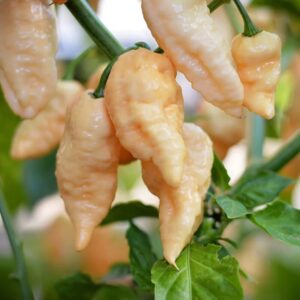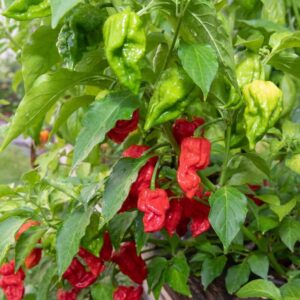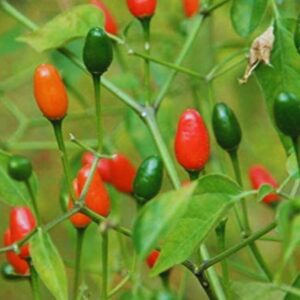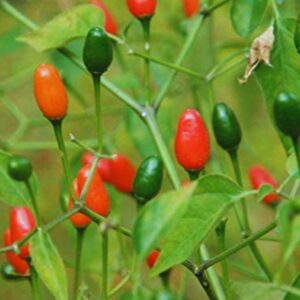Have you ever dreamed of picking fresh, fiery chili peppers from your own garden but felt limited by space? Good news—you don’t need a big backyard to grow these spicy delights. With a little care and the right setup, growing chili peppers in containers is not just possible; it’s incredibly rewarding.
It seems that most people now have at least 1 or 2 chili plants at home—it’s become incredibly trendy. Growing chilies is also super easy and great for beginner gardeners.
Our guide tells you how to do it the right way!

Why Grow Chili Peppers in Containers?
If you’re short on outdoor space or live in an urban area, container gardening is your best friend. Growing chili peppers in pots offer flexibility and control over growing conditions, allowing you to:
-
Place your plants in the sunniest spot.
-
Easily move them indoors during frost or bad weather.
-
Avoid many soil-borne pests and diseases.
Plus, chili peppers are compact plants that thrive in containers, making them a perfect choice for small spaces like balconies, patios, or even sunny windowsills.
Preparing for Planting Chili Peppers in Containers
Choose the Right Chili Pepper Variety
Not all chili peppers are created equal, especially for container gardening. Look for compact varieties that thrive in limited space, such as:
-
Thai Hot or Demon Red, Twilight, Apache: These small plants are perfect for a 1-litre pot and grow well on a sunny windowsill.
-
Jalapeño: A mild to moderately hot pepper, great for beginners.
-
Cherry Bomb: Produces a heavy crop of large red chilies with a great flavor that’s not too hot; one of the earliest varieties to ripen.
-
Cayenne: A versatile, medium-hot variety, excellent for drying and cooking.
-
Ring of Fire: A productive and tasty chili, perfect for culinary use.
-
Hungarian Hotwax: A milder chili with excellent flavor, ideal for stuffing recipes.
-
Habanero: Fruity and fiery, best for experienced spice lovers.
-
Patio Fire: Specifically bred for containers, featuring a vibrant, decorative look.
- Peach bhud jolokia ghost chili pepper: The world’s hottest pepper and easy to transplant into some corner in your kitchen.
Each of these varieties offers unique heat levels and flavors, so you can choose one that matches your spice tolerance and culinary needs. Their compact size and productivity make them excellent options for container gardening, whether on a balcony, patio, or sunny windowsill.
When Is the Best Time to Plant Chili Peppers in Containers?
Chili peppers thrive in warm conditions, so timing is crucial. Starting early indoors ensures they’ll be ready to produce as soon as the weather warms up.
If you plan to start from seeds, begin sowing chili seeds indoors 6-8 weeks before the last expected frost in your area. This is typically in late winter or early spring.
If you want to plant from small plants, observe that once all risk of frost has passed, typically in mid-to late spring, you can transplant your chili seedlings into larger containers outdoors. Ensure nighttime temperatures consistently stay above 55°F (13°C) to avoid stunting their growth.
If you live in a region with a mild winter and long growing season, you can plant chili peppers almost year-round, provided they receive adequate warmth and sunlight.
Selecting the Perfect Container
Choosing the right container is crucial for the health and productivity of your chili peppers. A well-chosen container not only supports healthy growth but also makes it easier to manage your chili pepper plants in small spaces like balconies, patios, or windowsills.
Consider selecting a container that is at least 12 inches in diameter and depth to provide enough space for the roots to grow and the plant to thrive. Larger containers can support bigger plants and reduce the frequency of watering.
Material:
-
Terracotta: A classic choice that provides good aeration and stability but may dry out faster.
-
Plastic: Lightweight, affordable, and retains moisture well.
-
Fabric Grow Bags: Excellent for drainage and preventing root-bound plants, while being easy to move around.
Drainage: Ensure the container has drainage holes to avoid waterlogging, which can lead to root rot. If your pot doesn’t come with holes, drill some at the bottom before planting.
Pro Tip: Consider using self-watering pots. These are especially helpful if you tend to forget to water or live in a hot climate where soil dries out quickly.
Preparing the Soil
Chili peppers thrive in well-draining, nutrient-rich soil. To create the perfect environment for your plants, start with a commercial potting mix specifically designed for vegetables or containers. These mixes are light, well-aerated, and retain moisture effectively.
Chili peppers prefer a slightly acidic to neutral pH, ideally between 6.0 and 7.0. Use a soil testing kit to check and adjust the pH as needed. If the pH is too low, add lime; if it’s too high, incorporate sulfur or acidic organic matter like pine needles.
Choosing the Right Location
Chili peppers are sun-lovers and need 6–8 hours of direct sunlight daily. If you don’t have a sunny spot, consider using grow lights. A south-facing balcony, patio, or windowsill is often ideal.
Step-by-Step Guide to Planting Chili Peppers in Containers
Now that you’ve gathered all your supplies, it’s time to plant your chili peppers! Whether you start from seeds or chili seedlings depends on your preference and experience:
Seeds vs. Seedlings:
- Seeds are cost-effective but require more time and patience as they need to germinate and grow.
- Seedlings give you a head start and are ideal for beginners or those with shorter growing seasons.
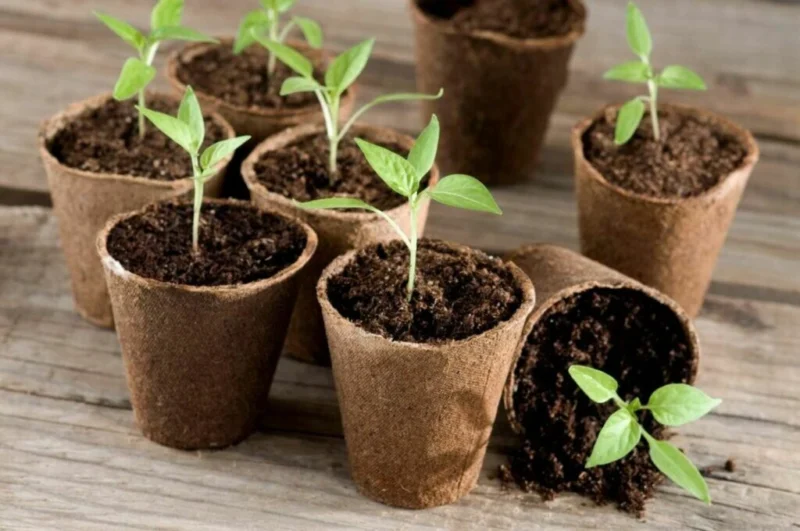
How to Grow Chilies from Seed in Containers
Growing chilies from seed in containers is a rewarding process that requires some planning and care.
-
Sow seeds between July and October. For very hot varieties, start as early as July since they need a long, warm growing season to produce well.
-
Soak seeds overnight in warm water to soften the seed coat.
-
Alternatively, place seeds between a damp paper towel inside a plastic bag and leave them in a warm spot for a few days to boost germination rates.
-
Use a high-quality seed-raising mix in small pots.
-
Sow seeds 5mm deep and keep the temperature between 18-21°C for optimal germination.
-
Cover the soil surface with perlite to retain moisture and heat, which chilies love.
-
Water the soil regularly, ensuring it stays moist but not waterlogged.
Transplanting Seedlings
-
Once the seedlings have developed two true leaves, transplant them into individual 9-10cm pots with nutrient-rich potting mix. Avoid touching the delicate roots during repotting to prevent damage.
Growing On and Hardening Off
-
Keep young plants at a temperature of 16-18°C to promote healthy growth.
-
If you plan to move them outdoors, harden off the plants gradually over 10-14 days by placing them outside during the day and bringing them in at night.
Final Growing Tips
-
Indoor Growing: Chilies love warm conditions, so if you don’t have a heated greenhouse, grow them on a sunny windowsill for extra warmth.
-
Feeding: Once established, feed your plants with vegetable fertilizer as per the instructions on the label.
-
Container Care: Choose appropriately sized containers and ensure they have good drainage to prevent waterlogging.
By following these steps, you’ll set your chili peppers up for a healthy and productive growing season. With proper care, you’ll soon enjoy fresh, homegrown chilies!
Chili Peppers in Containers Care
Watering Schedule: How Often Should You Water?
Proper watering is essential for healthy chili pepper plants. Keep the soil evenly moist, but avoid overwatering, as soggy soil can harm the roots.
Check the soil regularly and water only when the top inch of soil feels dry to the touch.
Ensure your container has good drainage to avoid water collecting at the bottom, which can lead to root rot.
Feeding Your Chili Pepper Plant: Fertilizers and Nutrients
-
Tomato fertilizers are an excellent choice for chili pepper plants, along with compost and well-rotted manure. A balanced 5-10-10 fertilizer typically provides all the nutrients peppers need. Before transplanting, incorporate the fertilizer into the soil at a rate of about 3 pounds per 100 square feet. For added nutrients, you can use a solution of fish emulsion and seaweed to boost plant health.
-
Once the peppers start forming, apply fertilizer again to support fruit development. Slow-releasing options like manure or compost are great for gradually enriching the soil. Keep in mind that the effectiveness of any fertilizer depends largely on your soil’s condition, so if you encounter growth issues, conducting a soil test can help identify deficiencies and guide your fertilization strategy.
-
Look for fertilizers labeled for vegetables, with nutrients like nitrogen (N), phosphorus (P), and potassium (K).
Pinching Your Pepper Plants for Bushier Growth
For bushier and healthier chili pepper plants, pinch the growing tip when the plant reaches about six inches tall. This encourages the plant to develop more branches, leading to a fuller structure and potentially higher yields.
Additionally, remove any flowers that appear too early. These early blooms can drain the plant’s energy, preventing it from focusing on strong root and foliage development. By pinching and removing early flowers, you’ll help your pepper plant grow more vigorously and set the stage for a more productive harvest.

Harvesting Chili Peppers in Pots
Chili peppers are ready to harvest when they are firm and have turned their mature color (red, orange, or yellow, depending on the variety). Use scissors or pruning shears to avoid damaging the plant.
Freshly picked chili peppers can be used in your favorite dishes, dried for long-term storage, or even frozen.
Container Gardening Tips
In Winter
-
Move your chili pepper plants indoors to protect them from frost and cold temperatures.
-
Place containers near a south-facing window or under grow lights to ensure they receive at least 6–8 hours of light daily.
-
Maintain indoor temperatures of 15–20°C (59–68°F) for optimal growth.
In Spring
-
Gradually harden off your chili plants over 10–14 days by placing them outside during the day and bringing them in at night. This helps them adjust to outdoor conditions.
-
If your plants have outgrown their containers, transplant them into larger pots (at least 12 inches in diameter) with fresh, nutrient-rich potting mix.
-
Use a soil mix amended with compost and perlite for better aeration and drainage.

FAQs About Growing Chili Peppers in Containers
Q1: Can I grow chili peppers indoors year-round?
Yes! With sufficient light (natural or grow lights) and warm temperatures, you can grow chili peppers indoors.
Q2: How big should my container be for chili peppers?
A container with a minimum of 12 inches in diameter and depth is ideal for most varieties.
Q3: Do chili peppers in pots need pollination to fruit?
Chili peppers are self-pollinating, but giving the plant a gentle shake can improve the fruit set.
Q4: How long does it take for chili peppers to grow?
From seed to harvest, most chili peppers take 60–90 days, depending on the variety.
Conclusion
Growing chili peppers in containers is a fantastic way to spice up your gardening routine, even if you don’t have much space. With the right care and setup, you’ll enjoy a bountiful harvest of homegrown peppers to elevate your culinary creations.
So, grab a pot, some seeds, and get growing—your spicy adventure awaits!
Related: How to grow pequin peppers
Dragons Breath Pepper Plant – How to Grow and Care for the World’s Hottest Pepper
RELATED PRODUCTS FOR YOU

